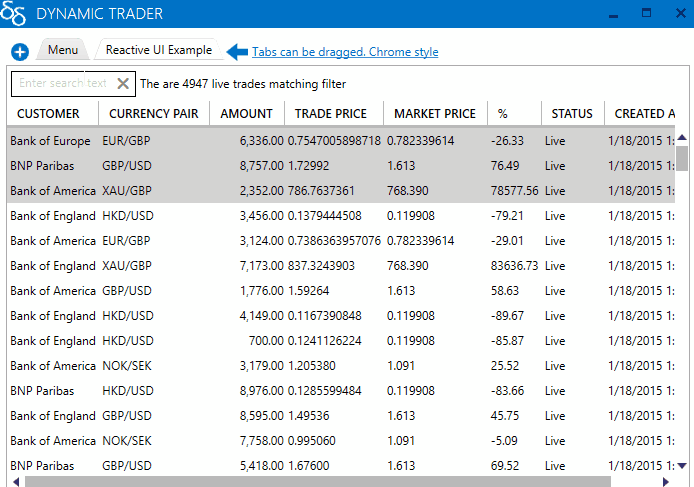I have released DynamicData.ReactiveUI which is a very simple adaptor layer to assist with binding dynamic data observables with reactiveui’s ReactiveList object.
Install from Nuget
If you are not familiar with dynamic data and what it enables I suggest:
- Go through previous posts in the blog
- Download the example wpf app from github
.
To cut to the chase, here’s an example. The code takes existing in-memory trade objects, transforms them into a view model proxy and updates the target reactive list object with the resulting change sets. It also pre-filters the data with live trades, applies a user entered filter, orders the resulting data and disposes the proxy when no longer required. Phew – all that in effectively one line of code.
I did the same example without using Reactive UI code see Trading Example Part 3. Integrate with UI where I have explained the code in greater detail
public class RxUiViewer : ReactiveObject, IDisposable
{
//this is the target list which we will populate from the dynamic data stream
private readonly ReactiveList<TradeProxy> _data = new ReactiveList<TradeProxy>();
//the filter controller is used to inject filtering into a observable
private readonly FilterController<Trade> _filter = new FilterController<Trade>();
private readonly IDisposable _cleanUp;
private string _searchText;
public RxUiViewer(ITradeService tradeService)
{
//Change the filter when the user entered search text changes
var filterApplier = this.WhenAnyValue(x => x.SearchText)
.Throttle(TimeSpan.FromMilliseconds(250))
.Subscribe(_ => ApplyFilter());
ApplyFilter();
var loader = tradeService.Trades
.Connect(trade => trade.Status == TradeStatus.Live) //prefilter live trades only
.Filter(_filter) // apply user filter
//if targetting Net4 or Net45 platform can use parallelisation for transforms 'cause it's quicker
.Transform(trade => new TradeProxy(trade), new ParallelisationOptions(ParallelType.Ordered, 5))
.Sort(SortExpressionComparer<TradeProxy>.Descending(t => t.Timestamp), SortOptimisations.ComparesImmutableValuesOnly)
.ObserveOn(RxApp.MainThreadScheduler)
.Bind(_data) //bind the results to the ReactiveList
.DisposeMany() //since TradeProxy is disposable dispose when no longer required
.Subscribe();
_cleanUp = new CompositeDisposable(loader, _filter, filterApplier);
}
private void ApplyFilter()
{
if (string.IsNullOrEmpty(SearchText))
{
_filter.ChangeToIncludeAll();
}
else
{
_filter.Change(t => t.CurrencyPair.Contains(SearchText, StringComparison.OrdinalIgnoreCase) ||
t.Customer.Contains(SearchText, StringComparison.OrdinalIgnoreCase));
}
}
public string SearchText
{
get { return _searchText; }
set { this.RaiseAndSetIfChanged(ref _searchText, value); }
}
public IReadOnlyReactiveList<TradeProxy> Data
{
get { return _data; }
}
public void Dispose()
{
_cleanUp.Dispose();
}
}
coupled with a little xaml can produce this
Very little code, but a very powerful example,


Reblogged this on iReadable.
LikeLike